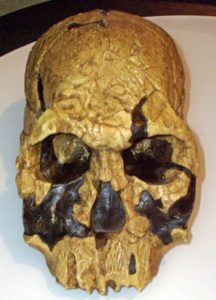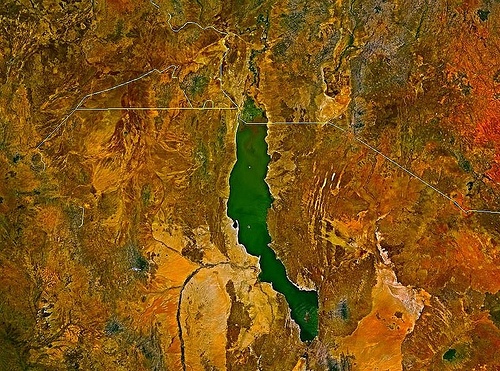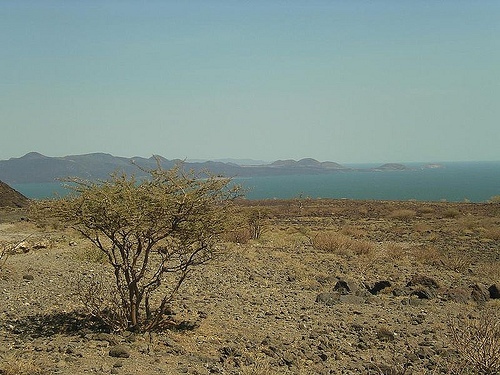
An international multi-disciplinary team of scientists have determined that a well-known group of early Homo (early human) fossils discovered in previous investigations at Koobi Fora in the Turkana Basin of East Africa have an age range that is older than previously estimated.
Led by archaeologist Josephine C.A. Joordens of the Netherlands’ Leiden University, the researchers combined magnetostratigraphy and strontium (Sr) isotope stratigraphy techniques to develop a new age constraint range for 15 selected hominin fossils found in deposits on the Karari Ridge of the Koobi Fora region in the eastern Turkana Basin (Kenya). Magnetostratigraphy measures the polarity of Earth’s changing magnetic field at the time a stratum (layer) was deposited. Strontium isotope stratigraphy involves measuring the ratios of Strontium isotopes in sediments to determine relative ages between successively deposited sediments. The fossils included key specimens such as cranium KNM-ER 1470, partial face KNM-ER 62000 and mandibles KNM-ER 1482, KNM-ER 1801, and KNM-ER 1802, all well-known among scientists and scholars involved in human evolution research. The fossil KNM-ER 1470, for example, has been classified as belonging to the early human species Homo rudolfensis, discovered by Bernard Ngeneo in 1972 and considered a possible theoretical contender for being ancestral to the human line. It has been dated to about 1.9 million years BPE.
_______________________________________________________________________________________________________________________
Satellite view of the Turkana Basin, Koobi Fora region, showing Lake Turkana. Fossils were found in an area just east of Lake Turkana. Wikimedia Commons
_______________________________________________________________________________________________________________________
Surface level view of Turkana Basin looking toward Lake Turkana. AdamPG, Wikimedia Commons
_______________________________________________________________________________________________________________________
Now, however, the results of their tests and analyses show a new age-range constraint of between 1.945 ± 0.004 and 2.058 ± 0.034 Ma, making the fossil finds older than previously estimated, and providing a sharper, more specific age range for their deposit.
“To address questions regarding the evolutionary origin, radiation and dispersal of the genus Homo,” writes Joorden, et al. in their report, “it is crucial to be able to place the occurrence of hominin fossils in a high-resolution chronological framework. The period around 2 Ma (millions of years ago) in eastern Africa is of particular interest as it is at this time that a more substantial fossil record of the genus Homo is first found.”
In addition to the new age range, their research shed light on the possible geographic origins and ecological/climatological adaptability of these early humans. As they report:
“……..our results show that in this time interval, hominins occurred throughout the wet–dry climate cycles, supporting the hypothesis that the lacustrine Turkana Basin was a refugium during regionally dry periods. By establishing the observed first appearance datum of a marine-derived stingray in UBU [upper Burgi] deposits at 2.058 ± 0.034 Ma, we show that at this time the Turkana Basin was hydrographically connected [via a postulated ancient ‘Turkana River’] to the Indian Ocean, facilitating dispersal of fauna between these areas. From a biogeographical perspective, we propose that the Indian Ocean coastal strip should be considered as a possible source area for one or more of the multiple Homo species in the Turkana Basin from over 2 Ma onwards.”
The study report, Improved age control on early Homo fossils from the upper Burgi Member at Koobi Fora, Kenya, has been published in the December 2013 issue of the Journal of Human Evolution.
___________________________
Cover photo, Top Left: Homo rudolfensis skull (KNM ER 1470) reconstruction displayed at Museum of Man, San Diego. Durova, Wikimedia Commons
_______________________________________________________________________________________________________________________
Read about the most fascinating discoveries with a premium subscription to Popular Archaeology Magazine. Find out what Popular Archaeology Magazine is all about, including the special Holiday Discount offer. AND MORE:
 Popular Archaeology’s annual Discovery edition is a selection of the best stories published in Popular Archaeology Magazine in past issues, with an emphasis on some of the most significant, groundbreaking, or fascinating discoveries in the fields of archaeology and paleoanthropology and related fields. At least some of the articles have been updated or revised specifically for the Discovery edition. We can confidently say that there is no other single issue of an archaeology-related magazine, paper print or online, that contains as much major feature article content as this one. The latest issue, volume 2, has just been released. Go to the Discovery edition page for more information.
Popular Archaeology’s annual Discovery edition is a selection of the best stories published in Popular Archaeology Magazine in past issues, with an emphasis on some of the most significant, groundbreaking, or fascinating discoveries in the fields of archaeology and paleoanthropology and related fields. At least some of the articles have been updated or revised specifically for the Discovery edition. We can confidently say that there is no other single issue of an archaeology-related magazine, paper print or online, that contains as much major feature article content as this one. The latest issue, volume 2, has just been released. Go to the Discovery edition page for more information.
Subscription Price: A very affordable $5.75 for those who are not already premium subscribers of Popular Archaeology Magazine (It is FREE for premium subscribers to Popular Archaeology). Premium subscribers should email [email protected] and request the special coupon code. Or, for the e-Book version, it can be purchased for only $3.99 at Amazon.com.






